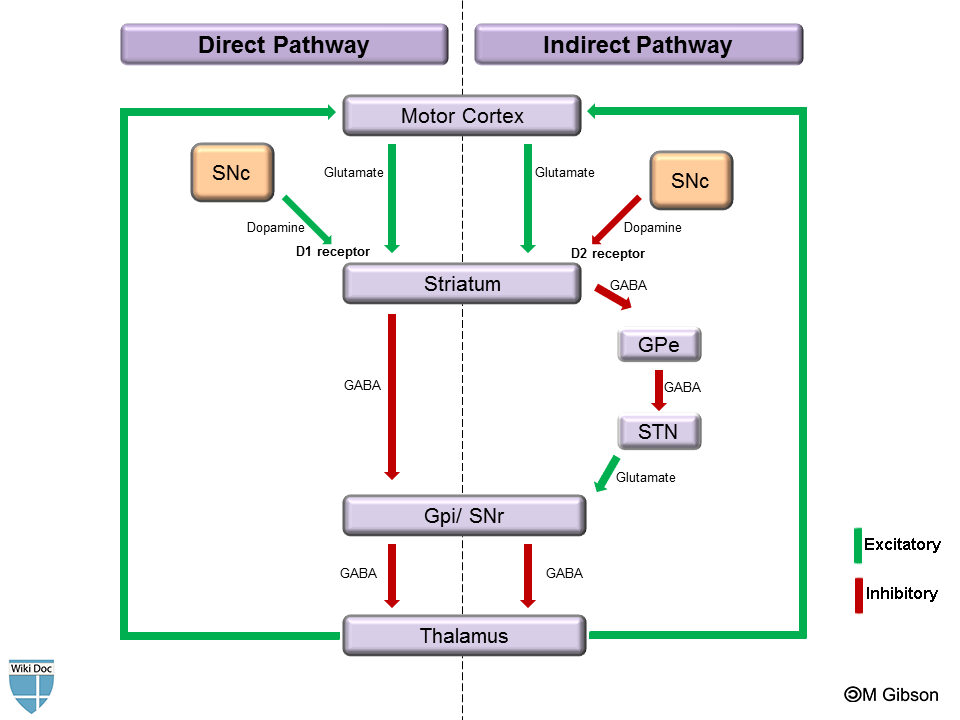WBR0573
| Author | [[PageAuthor::Rim Halaby, M.D. [1] (Reviewed by Alison Leibowitz [2] and Yazan Daaboul, M.D.)]] |
|---|---|
| Exam Type | ExamType::USMLE Step 1 |
| Main Category | MainCategory::Pathophysiology |
| Sub Category | SubCategory::Neurology |
| Prompt | [[Prompt::A 68-year-old man with a past medical history of chronic stable angina and hypertension presents to the emergency department with violent involuntary movements of his right extremities for the past 3 hours. The patient explains that these attacks began suddenly and have since been repetitive and uncontrollable. Physical examination is remarkable for non-rhythmic, continuous, violent flinging motions of the right upper and lower extremities. Although a cranial CT scan is negative, an underlying small ischemic stroke is still suspected. Which of the following receptors is a significant component of the pathway involved in this patient's condition?]] |
| Answer A | AnswerA::α-adrenergic receptors |
| Answer A Explanation | [[AnswerAExp::α-adrenergic receptors may be either α1 or α2. α1-receptors have a role in vasoconstriction, pupillary dilation, and bladder sphincter muscle contraction. α2-receptors have a role in decreasing sympathetic outflow, insulin release, and lipolysis. α-adrenergic receptors are not involved in modulation of skeletal muscle function.]] |
| Answer B | AnswerB::5-HT2 receptors |
| Answer B Explanation | AnswerBExp::5-HT2 receptors are not part of the inhibitory pathway of the basal ganglia. 5-HT2 mediate many of the central and peripheral physiologic functions of serotonin. |
| Answer C | AnswerC::Nicotinic receptors |
| Answer C Explanation | [[AnswerCExp::Nicotinic acetylcholine receptors are transmitter-gated ion channels that bind acetylcholine. They are responsible for the postsynaptic action potential transmission at the neuromuscular junction. Although muscarinic acetylcholine receptors may be involved in the basal ganglia motor circuit, nicotinic receptors have no major role.]] |
| Answer D | AnswerD::Dopamine D1 receptors |
| Answer D Explanation | [[AnswerDExp::Dopamine D1 receptors are involved in the excitatory or direct pathway in the basal ganglia. A decrease in D1 receptor activity or a defect in the excitatory pathway results in a decrease in locomotor activity. An imbalance favoring the D1 excitatory pathway over the inhibitory D2 pathway leads to increased locomotor activity, which manifests as chorea, athetosis, or hemiballismus.]] |
| Answer E | AnswerE::Dopamine D2 receptors |
| Answer E Explanation | [[AnswerEExp::Dopamine D2 receptors are involved in the inhibitory or indirect pathway that causes a net decrease in locomotor activity. A defect in the inhibitory pathway, such as a subthalamic nucleus lesion, results in a shift of the balance toward the excitatory pathway and increased movement, which is observed in hemiballismus, chorea, and athetosis.]] |
| Right Answer | RightAnswer::E |
| Explanation | [[Explanation::Hemiballismus is a rare hyperkinetic disorder characterized by involuntary movements of large amplitude that involves one limb or ipsilateral limbs. The movements are often repetitive, irregular, and poorly-patterned. They arise from an insult to the contralateral subthalamic nucleus, which results in an imbalance between the excitatory and inhibitory pathways of the basal ganglia. The subthalamic nuclei are significant components of the inhibitory pathway and are involved in modulating locomotor activity by dopamine-mediated binding to D2 receptors. The inhibitory pathway involves disinhibition of the subthalamic nucleus by the globus pallidus externus (GPe), allowing the subthalamic nuclei to activate the globus pallidus internus (GPi). In turn, the GPi inhibits the thalamus and decreases movement. Any process focal to the subthalamic nucleus or its connections may cause hemiballismus. In elderly patients, the most common cause of hemiballismus is a vascular lesion, such as a small lacunar stroke that involves the small vessels. In contrast, young patients usually have an underlying infection or inflammatory process.
Below is an illustration that demonstrates the direct and indirect pathways in the basal ganglia  Educational Objective: Hemiballismus frequently leads to involuntary flinging of extremities that are contralateral to the side of the lesion. Hemiballismus is caused by a lesion in the subthalamic nucleus of the basal ganglia. The subthalamic nuclei are an important component of the inhibitory pathway, where they regulate locomotor activity mediated by dopamine binding to D2 receptors. |
| Approved | Approved::Yes |
| Keyword | WBRKeyword::Hemiballismus, WBRKeyword::Basal ganglia, WBRKeyword::Dopamine, WBRKeyword::Dopamine receptors, WBRKeyword::Inhibitory pathway, WBRKeyword::Excitatory pathway, WBRKeyword::hormones, WBRKeyword::neuroscience, WBRKeyword::neurology |
| Linked Question | Linked:: |
| Order in Linked Questions | LinkedOrder:: |